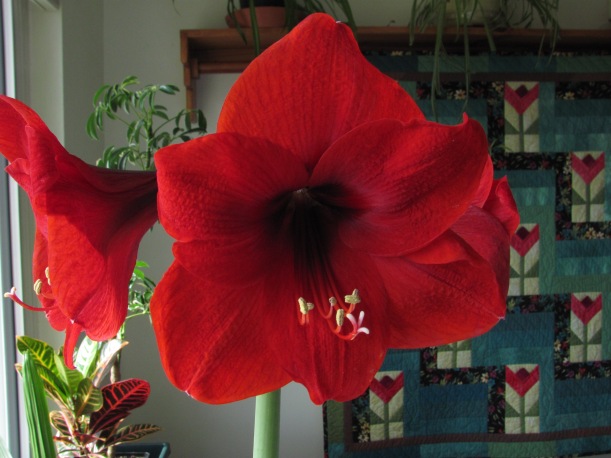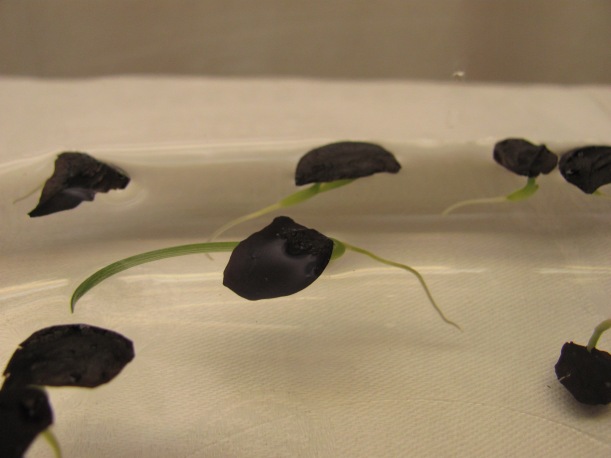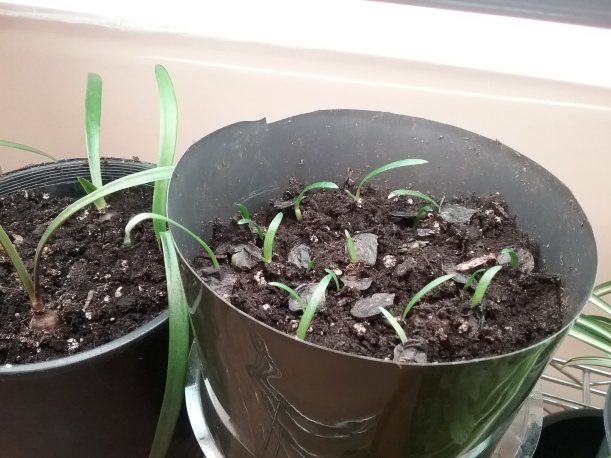
Amaryllis is a popular flower at Christmas time, but without forcing, it prefers to bloom in spring. Photo by Barb Gorges.
Published Dec. 17, 2017, in the Wyoming Tribune Eagle, “Amaryllis beyond the holidays: reblooming and propagation.”
By Barb Gorges
In the pantheon of Christmas season flowering plants, I’ll take the elegant amaryllis and its big blossoms any day. Oh wait, I don’t have any more room on my windowsill.
What started as two amaryllis gifts 10 years ago has become numerous “daughters” and seedlings.
The amaryllis you see listed in catalogs and for sale at garden centers, florists and grocery stores during the holidays are intended to be disposable. But it really isn’t difficult to get them to bloom again, though there is a trick to get them to perform next Christmas. Growing them from seed you collect yourself takes only patience.
Beware
Beware of amaryllis bulbs encased in colorful wax decorated with glitter. They flower without any need for dirt or water because the bulbs are large and contain nutrients needed for blooming. Just set them on a saucer. But it seems to me cruel and unusual punishment to bind a bulb in wax and let it die after flowering.
Beware the decorative pot that may come with your bulb. It doesn’t have a drainage hole. No fuss, no muss. But if you want to keep your holiday amaryllis from year to year, replant it in a pot with a drainage hole. The proper pot size leaves about an inch between the side of the bulb and the side of the pot. Plant the bulb so that nearly half of it is above the soil.
Watering and fertilizing
Without a drainage hole, you are never sure if you have given a plant enough water or if there’s a big underground puddle rotting the roots. It’s best to water a potted plant a bit at a time until water emerges through the drainage hole and then dump the excess water.
Watering amaryllis once a week works in the winter climate of our Cheyenne house which has 20-40 percent humidity, is at 64 degrees Fahrenheit during the daytime and cooler at night. The peat-based potting soil holds water well enough, but I allow the top inch of soil to dry out. Little black fungus gnats mean I’m watering too much.
I fertilize my amaryllis maybe at 25 percent or less of what is recommended on houseplant fertilizer packages. My friend Jane Dorn has an enormous pot of enormous bulbs that bloom two to three times a year and she only fertilizes once a year.
Dormancy for forcing or wintering
If you want to force your amaryllis to bloom for Christmas next year, treat it as a houseplant over the summer. In early September, unearth it carefully, wash off the dirt, trim the roots to 1-2 inches long and trim the leaves 1-2 inches above the neck.
You Tube’s Amaryllis Man Charlie Johnston says to let the bulbs dry for three weeks before refrigerating them for 6 weeks. You can also do this if you don’t have room indoors in the winter for a lot of big floppy-leaved plants.
Take the bulbs out 5-6 weeks before you want them to bloom and repot them. Bulbs are in this condition when you buy them for holiday blooming.
Reblooming naturally
I don’t let my amaryllis go dormant. The first year I had one, I decided to keep watering it year-round and it bloomed again in spring following the next Christmas.
I put my amaryllis plants out for the summer on our covered patio. The roof is translucent plastic, shady by afternoon. It also protects plants from hail and hard rain. I put the plants back inside a sunny window in September and wait.
Looking at my records, flowering begins anytime between the end of February and early April and lasts for a month. My two varieties don’t bloom at the same time as each other.

This pot of pink amaryllis has a mother bulb, two blooming daughter bulbs on either side, and a couple baby bulbs sending up their first leaves. Photo by Barb Gorges.
Mothers and daughters
If you keep your amaryllis from year to year, you may discover your bulb gets bigger and bigger and/or produces offsets, or daughters. You can leave these new bulbs attached and let them mature and bloom. You may have to accommodate them with a bigger pot at some point.
Or, you can carefully unearth the whole mass and break off the daughters and repot them separately, to give away or keep. The Amaryllis Man soaks his bulbs, leaves and roots in a fungicide for 10 minutes before planting, but I haven’t found that necessary.
See the Amaryllis Man for how to force daughter bulbs to develop by “chipping,” https://www.youtube.com/watch?v=LAoIelfGWdg.

Each amaryllis flower has six anthers and a stylus. Pollination happens when the pollen on the anthers starts dusting everything and the tip of the stylus opens. Photo by Barb Gorges.
Seedlings
I found growing amaryllis from seed is surprisingly easy, although it can take four years to get blooms.
First, make sure the flowers get pollinated. I had one plant flower in the summer outside where some insects did the job. I’ve also had indoor plants pollinate themselves or I can help them.
Amaryllis flowers make an excellent demonstration of plant reproduction. There are 6 yellow pollen-tipped anthers. You’ll know when the pollen is ripe because it starts dusting everything. At that moment, the end of the single stylus should be open. You can dab pollen on the end of it.
 If you are successful, the ovary will begin to swell right behind the flower petals. A three-lobed pod will develop. Leave it on the flower stem. When it turns brown, it will split open and you can collect the seeds.
If you are successful, the ovary will begin to swell right behind the flower petals. A three-lobed pod will develop. Leave it on the flower stem. When it turns brown, it will split open and you can collect the seeds.
Each tiny seed is encased in a flat black wafer. You can give the wafers a couple weeks to cure. Their germination rate will be highest if you sprout them right after that.

The wafer-like seeds of the amaryllis can be floated on water until they sprout in three or four weeks and can be transplanted into soil. Photo by Barb Gorges.
While you can start these seeds as you would flower or vegetable seeds, in a flat of a seed-starting medium like a perlite-peat mix kept moist, I found it more fun and easier (no constant checking soil moisture) to float the seeds on water. After three or four weeks, they sprout tiny leaves and roots with the tiniest bulge of the future bulb. Once they are big enough to grab, you can transplant them as you would any seedling.
But now comes the hard part, waiting for the seedlings to grow up. The Amaryllis Man says some will bloom as early as three years old, but usually it’s four.
Sigh.
That means I have two or three more years before I find out if the cross pollination of my red and pink varieties will yield anything interesting.

The amaryllis seedlings on the left are about a year old. The seedlings on the right are newly transplanted after sprouting in water. Photo by Barb Gorges.
Where to buy
If you don’t have any amaryllis yet, it isn’t too late to find them at stores and in catalogs. If you plant a bulb in January, it will bloom at its natural blooming time in early spring.
You may find bulbs marked down at our local garden centers and grocery stores now. Catalogs like Jackson and Perkins or Breck’s offer more variety. And then there’s the Amaryllis Man’s website, http://stores.ebay.com/amaryllisman. If you don’t need your amaryllis in variations of Christmas red and white, he offers some that are orange.
Hmm.
I might have room on my windowsill for one of those if I find another home for my rubber tree….
 Update, March 1, 2018:
Update, March 1, 2018:
Typically, my amaryllis bloom in February or March. This year they started blooming in mid-January. Only one decided to hold out until the end of February. Just before the petals of one of the early bloomers started to wilt, I touched the anthers to the pistil and now the seed pods are swelling.
